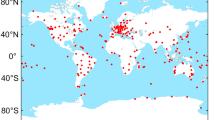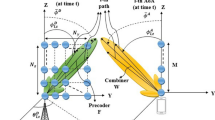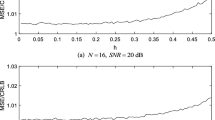Abstract
In order to solve the angle estimation problem of coherent sources in the impulse noise background, an algorithm based on infinite norm normalization preprocessing and sparse representation (INN-SR) is proposed. First, an infinite norm normalization preprocessing method is used to reduce the impact of the impact noise. Then the sparse decomposition method is used to construct the restoration dictionary to estimate the DOA and DOD. Finally, accurate matching of target DOA and DOD is achieved based on maximum likelihood method. The algorithm does not need to know the number of sources and can also work well for coherent sources.



Similar content being viewed by others
Data Availability Statement
The data in this paper are mainly some actual measurement impulse noise data. The interference data used to support the findings of this study are available from the corresponding author upon request.
References
You, G., Jiang, B., Qin, H., et al. (2017). A novel cyclic correntropy MUSIC algorithm of cyclostationary signal based on UCA in impulsive noise. IEEE 2017 Chinese Automation Congress, Jinan, China, pp. 2820–2823.
You, G., Qin, H., Wang, Z., et al. (2017). A novel MUSIC algorithm based on cyclic correntropy in impulsive noise. IEEE 2017 29th Chinese Control and Decision Conference, Chongqing, China, pp. 5213–5216.
Hu, R., Fu, Y., Chen, Z., Xu, J., et al. (2017). Robust DOA estimation via sparse signal reconstruction with impulsive noise. IEEE Communications Letters, 21(6), 1333–1336.
Li, S., He, R., Lin, B., et al. (2018). DOA estimation based on sparse representation of the fractional lower order statistics in impulsive noise. IEEE/CAA Journal of Automatica Sinica, 5(4), 860–868.
Yang, Z. (2018). Direction-of-arrival estimation using atomic norm methods: Affects of multiple snapshots and coherent sources. IEEE International Conference on Computational Electromagnetics, Chengdu, China, pp. 1–3.
Wu, X., Zhu, W.-P., Yan, J., et al. (2018). A spatial filtering based gridless DOA estimation method for coherent sources. IEEE Access, 6, 56402–56410.
Shao, M., & Nikias, C. L. (1993). Signal processing with fractional lower order moments: Stable processes and their applications. Proceeding of the IEEE, 81(7), 986–1010.
Nikias, C. L., & Shao, M. (1995). Signal processing with alpha stable distribution and applications. New York: John Wiley & Sons Inc.
Kuruoglu, E. E., Rayner, P. J. W., & Fitzgerald, W. J. (1997). Least Lp-norm estimation of autoregressive model coefficients of symmetric α-stable processes. IEEE Signal Processing Letters, 4(7), 201–203.
Gross, S., & Steiger, W. L. (1979). Least absolute deviation estimates in autoregression with infinite variance. Journal of Applied Probability, 16(1), 104–116.
An, H.-Z., & Chen, Z.-g. (1982). On convergence of LAD estimates in autoregression with infinite variance. Journal of Multivariate Analysis, 12(3), 335–345.
Hari, K. V. S., & Lalitha, V. (2011). Subspace-based DOA estimation using fractional lower order statistics. IEEE Conference on Acoustics, Speech and Signal Processing. Czech Republic, Prague, pp. 2580–2583.
Ming, D., Lili, Y., & Chao, C. (2010). DOA estimation of spatial-temporal and maximum-likelihood based on fractional lower-order statistics. Application Technology, 37(4), 15–18.
He, J., & Liu, Z. (2006). DOA estimation in impulsive noise environment using fractional lower order spatial-temporal matrix. Journal of Aeronautical, 27(1), 104–108.
Zhao, J., He, D., & Wang, W. (2016). Robust ESPRIT algorithm based on correntropy. Computer Engineering and Design, 37(2), 438–442.
Diao, M., & An, C. (2013). A novel DOA estimation method in impulsive noise. Journal of Beijing University of Posts and Telecommunications, 36(5), 100–104.
Malioutov, D., Cetin, M., & Willsky, A. S. (2005). A sparce signal reconstruction perspective for source localization with sensor arrays. IEEE Transactions on Signal Processing, 53(8), 3010–3022.
Wu, X., Zhao, Y., Zhang, S., et al. (2008). New method for DOA estimation for the MIMO radar in low-angle tracking environment. Journal of Xidian University, 35(5), 793–798.
Li, L. (2015). Joint parameter estimation and target localization for bistatic MIMO radar system in impulsive noise. Signal Image & Video Processing, 9(8), 1–9.
Funding
This work was supported by the China Postdoctoral Science Foundation under Grant no. 2019M662257 and the Aeronautical Science Foundation of China under Grant no. 201901096002.
Author information
Authors and Affiliations
Contributions
Jian Gong proposed the basic flow of the INN-SR algorithm. Yiduo Guo established the echo model of bistatic MIMO radar. Jian Gong and Yiduo Guo verified the performance of proposed algorithm by simulation experiment results. Jian Gong drafted the manuscript and made repeated critical revisions. Both authors read and approved the final manuscript.
Corresponding author
Ethics declarations
Conflict of interest
No potential conflict of interest was reported by the authors.
Additional information
Publisher’s Note
Springer Nature remains neutral with regard to jurisdictional claims in published maps and institutional affiliations.
Rights and permissions
About this article
Cite this article
Gong, J., Guo, Y. A Bistatic MIMO Radar Angle Estimation Method for Coherent Sources in Impulse Noise Background. Wireless Pers Commun 116, 3567–3576 (2021). https://doi.org/10.1007/s11277-020-07865-3
Accepted:
Published:
Issue Date:
DOI: https://doi.org/10.1007/s11277-020-07865-3




